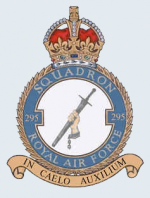295 squadron

My involvement with 295 Squadron, which at the time was under the auspices of 38 Wing who had its Headquarters at RAF Netheravon, started in June 1943 when I was posted to RAF Holmsley South. I had previously been at the Operational Training Unit at RAF Cranwell and on passing out our newly assembled crew thought we were destined for Coastal Command, as our type of training had indicated.
Instead of which, we found ourselves midst Gliders and Paratroopers with whom we were to become integrated over the following months and years. Quite a lot of June 1943 was taken up with training flights involving the Airborne Divisions. In late June, the crew were involved in taking a Wellington to North Africa to take part in Glider towing experiments. I myself, was not part of this trip because whilst at RAF Hurn, I was hospitalised for treatment on a huge carbuncle that had developed on my neck. My crew were in North Africa for almost a month as they did not return to our home base until the end of July. August and September consisted of cross country flights to various ‘dropping zones’, dummy dropping of troops, towing exercises including formation flying, live dropping of troops all carried out with the Armstrong Whitworth Whitley aircraft.
In November 1943 we had the first of the Albemarle aircraft in use by the squadron so this month, as well as December, consisted of familiarisation through lots of local flying and cross country trips.

1944 saw a continuation of training flights and exercises with Paratroopers, the sequence was broken only by an SOE trip in early February when we were involved in a 3hr night trip to France . In March of that year the squadron was moved from Hurn to RAF Harwell . With the Albemarle aircraft it was a continuous programme of towing or dropping troops and it was a similar period right through until June. On June 5th at a take-off time of 2320, we were part of Operation “ Tonga ”. The trip was reasonably uneventful except perhaps for our encounter with quite a low based bank of cloud just prior to reaching the French coast. With resourcefulness, our skipper literally ‘dragged’ the glider through the clouds in a downward direction until we broke from the cover. We were then able to continue and released our Glider as planned.
On June 7th we were involved in Operation “Cooney” which was the carrying of some SAS Troops to be dropped into the hinterland of the “Overlord” operation.
In July 1944 we were to become converted to the four-engine Stirling aircraft and for this we attended the 1665 Heavy Conversion Unit which was at RAF Tilstock . In August we made our first SOE trip in a Stirling with a trip of nearly six hours. Later in the month there was another SAS trip carrying 12 men which this time was quite deep into the continent. Unfortunately the trip had to be aborted due to seriously bad weather and we had to return, some very disgruntled men to base after nearly nine hours.
September 1944 had us down for another SAS trip to France followed by an SOE on the middle of the month. Sunday September 17th is a date well known in the annals of 38 Group as this was the first trip for the involvement with Operation “Market Garden”. This was also the first daylight operation that we had experienced. We were off at 1135 hrs and made our return nearly five hours later, after having delivered our Glider successfully. The following day we were loaded up with containers that fitted in the bomb bays as well as large pannier baskets which had to be kicked out at the rear of the aircraft at the appropriate moment. This was the job of the Wireless Operator and the Rear Gunner who also had the task of retrieving the static lines after the drop. A further re-supply trip was executed on the Wednesday September 20th.
The last three months were given over to training of all sorts, which as we now know, were aimed at bringing about Operation “Varsity”. In November, the crew were involved in an operation that consisted of a seven hour search of the North Sea in a bid to find Group Captain Surplice who had gone missing on a trip to Norway. In late December the squadron was again moved, this time to take over a previous airfield used by the American Air Force at Rivenhall . This was a move to bring 38 Group and its squadrons much closer to the Continent and the forthcoming Rhine crossing battle.

Before this Operation could take place in March 1945, several crews were posted from 38 Group Squadrons to form 46 and 242 Squadrons which were then being formed as part of Transport Command and we were to be stationed at RAF Stoney Cross. Thus ended my time with 38 Group but not with Stirling aircraft. The Transport Command Squadrons were equipped with the mark V version which carried no armament whatsoever and were involved in moving men and machinery to the Far East area of operations.
Norman FENDALL
Ex 295 Squadron RAF

Note:
Norman flew with Flight Lieutenant John UNWIN; his entire flying from 1943 until 1946 was with John as the pilot.
Their crew was slightly different when they converted to the four engine Stirling as they gained the addition of a Flight Engineer.
Crew of Albemarle aircraft:-
Pilot: Flight Lieutenant John UNWIN (100548)
Navigator: Flight Lieutenant Don COCHRANE RCAF (J.13971)
Bomb Aimer: Flying Officer Ray JOY (145389)
Wireless Operator: Flying Officer Norman FENDALL (173105)
Air Gunner: Flight Sergeant Jack WALTER (1313731)
and for the Stirling aircraft was added
Flight Engineer: Sergeant Trevor COOKE (1594193)
Back to: 38 Group Veterans’ stories

